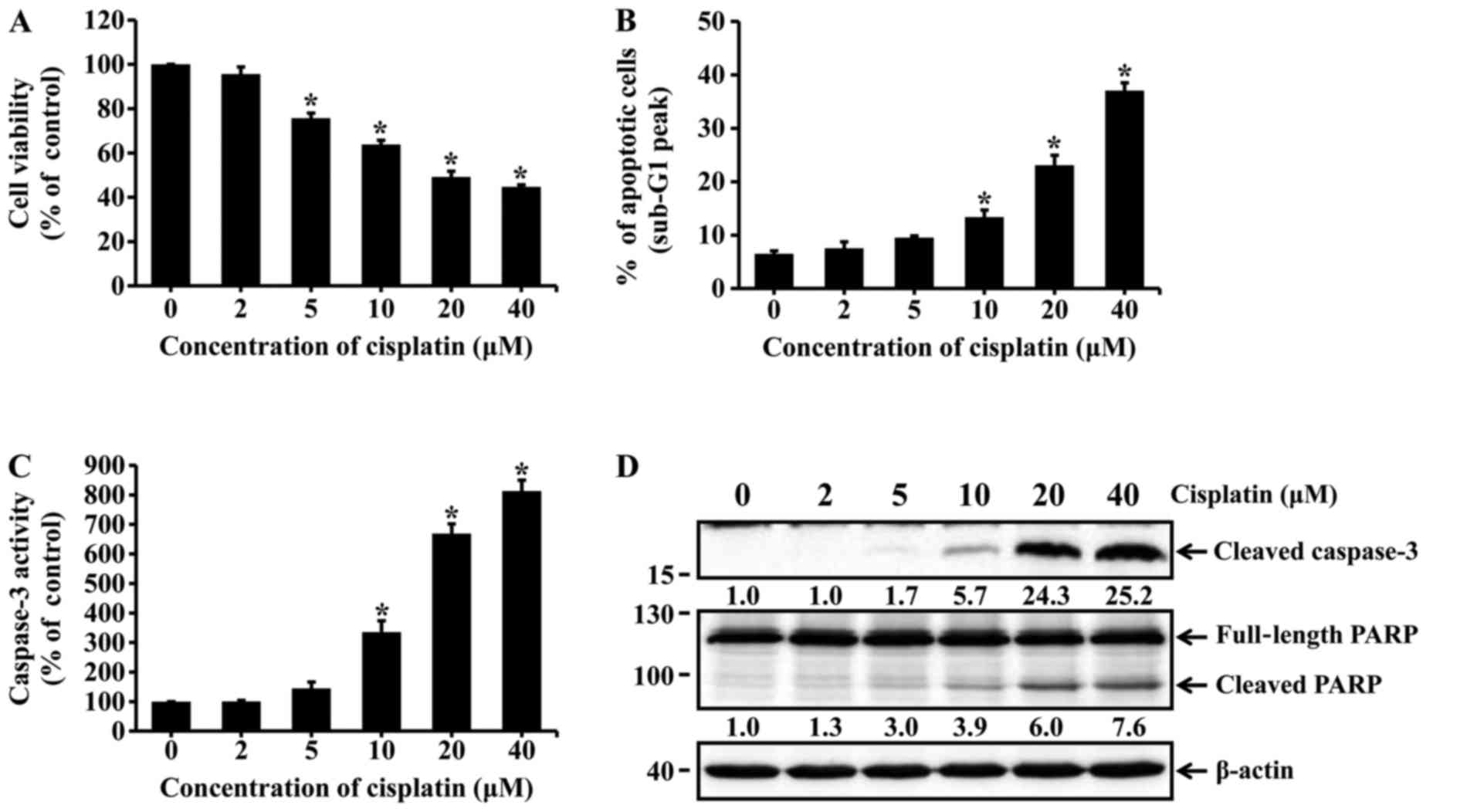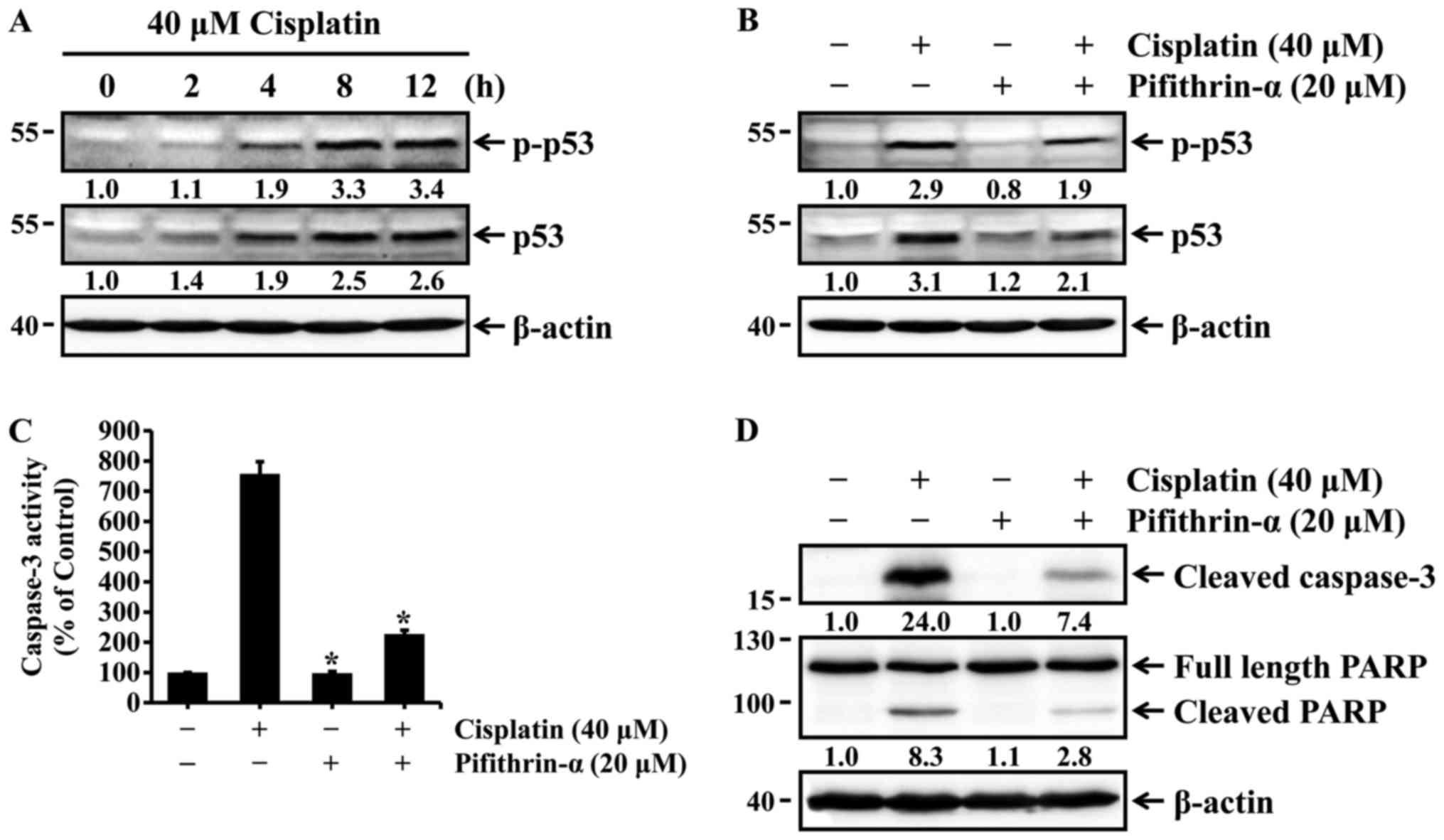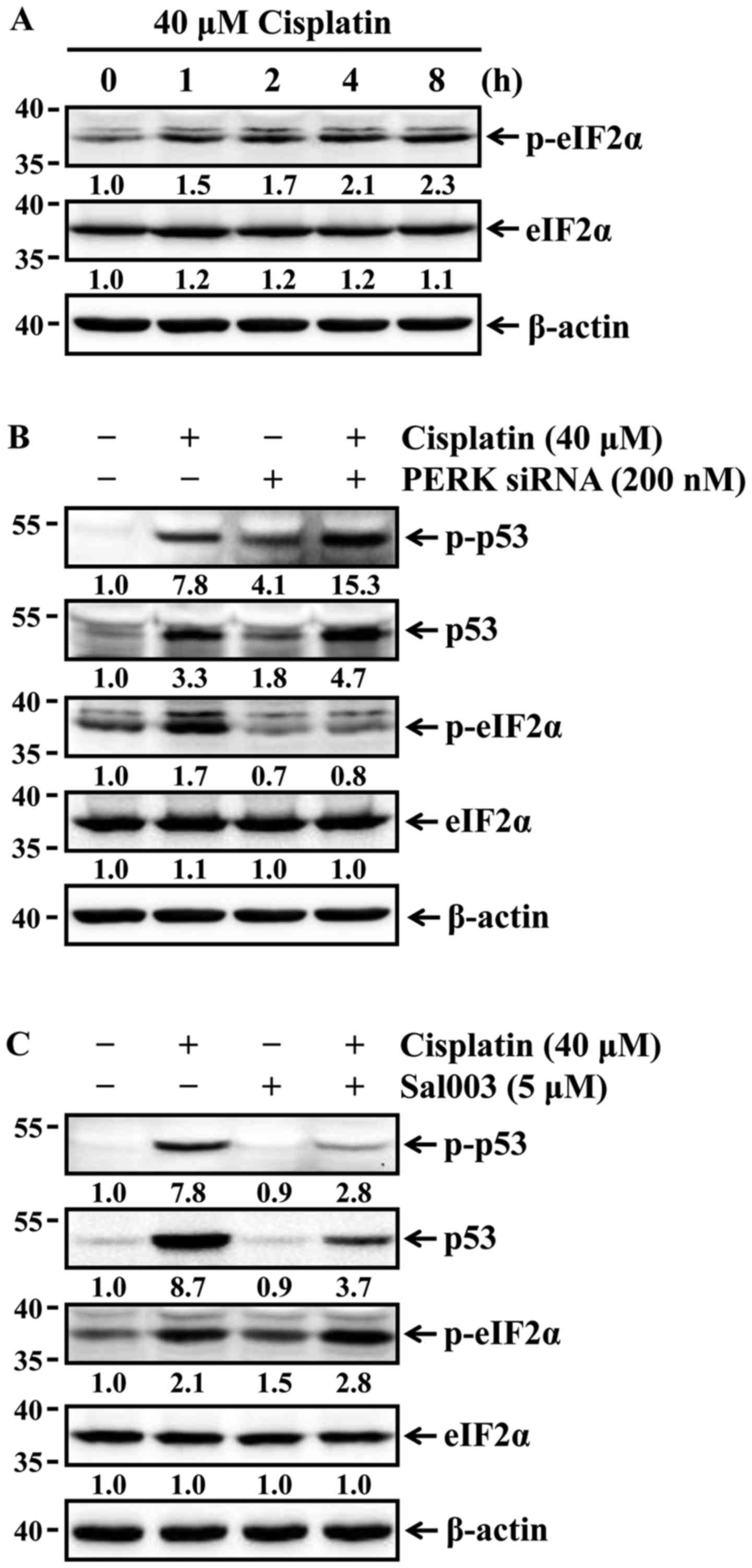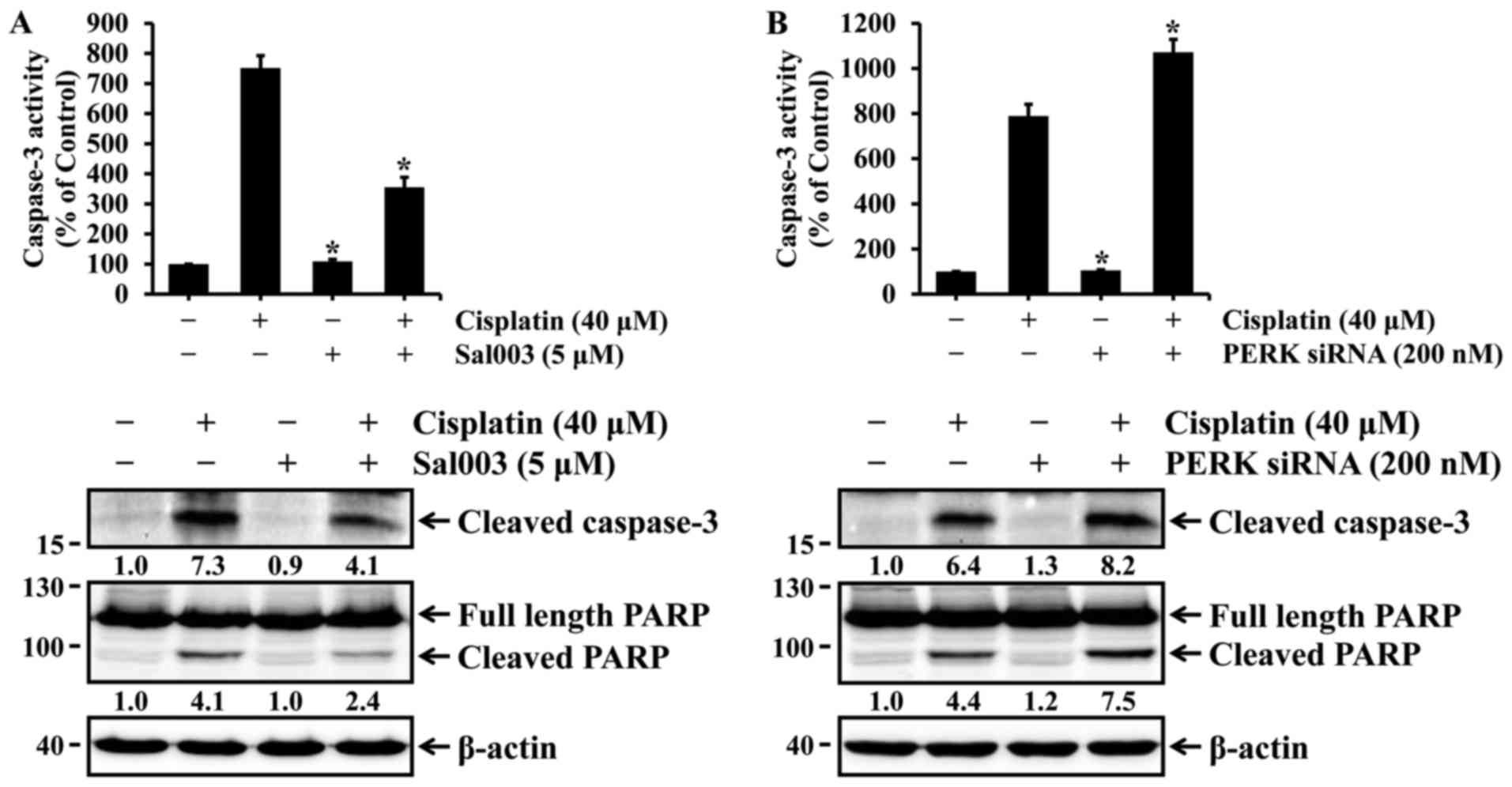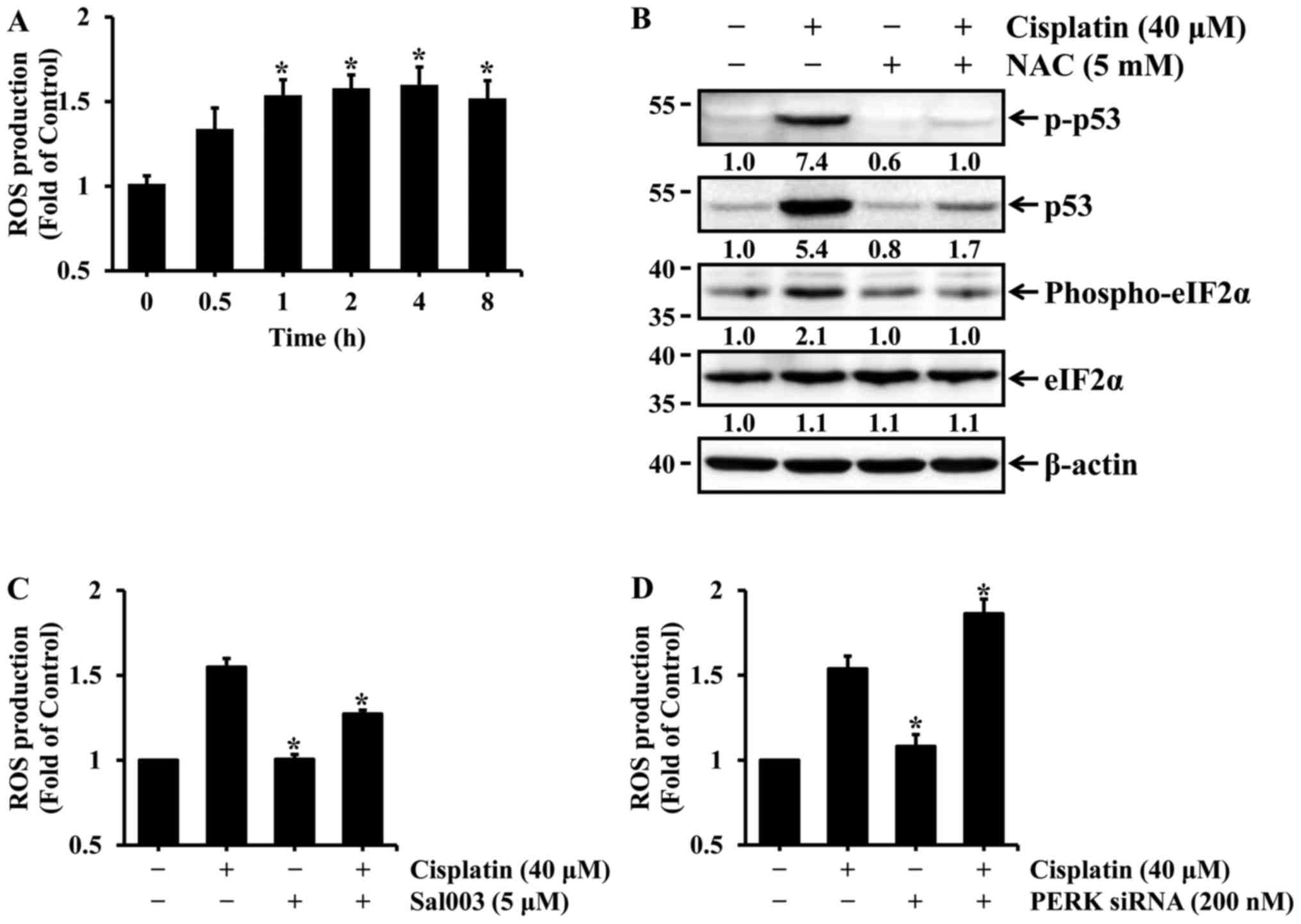Phosphorylation of eIF2α suppresses cisplatin-induced p53 activation and apoptosis by attenuating oxidative stress via ATF4-mediated HO-1 expression in human renal proximal tubular cells
- Authors:
- Published online on: October 10, 2017 https://doi.org/10.3892/ijmm.2017.3181
- Pages: 1957-1964
Abstract
Introduction
Cisplatin [cis-diamminedichloroplatinum(II)] is a potent chemotherapeutic agent, which is widely used for the treatment of human cancers (1,2). However, the clinical application of cisplatin is limited by nephrotoxicity, leading to acute renal failure (3–6). Cisplatin accumulates predominantly in the kidney, as this is the major route for its excretion (7). Therefore, cisplatin nephrotoxicity appears to be associated with its accumulation in the kidney.
Cisplatin nephrotoxicity is a complex multifactorial process, including oxidative stress, mitogen-activated protein kinases, p53 tumor suppressor and inflammation (8). In particular, reactive oxygen species (ROS) and p53 have been shown to be important factors contributing to cisplatin nephrotoxicity. Cisplatin induces oxidative stress by generating ROS in renal cells, which leads to the activation of apoptotic pathways (9–11). p53 is activated during cisplatin nephrotoxicity and contributes to renal cell injury and death (12). Of note, p53 may be activated by ROS during cisplatin treatment of renal cells (13,14). Moreover, ROS scavengers and p53 inhibitors may prevent cisplatin-induced apoptosis by suppressing the activation of p53 in renal cells (13–15). This suggests that regulation of p53 activity may be an important target for alleviating cisplatin nephrotoxicity.
Cisplatin nephrotoxicity is also associated with endoplasmic reticulum (ER) stress (16). Pre-activation of ER stress alleviates cisplatin-induced nephrotoxicity in various renal cell lines (17). ER stress, which may be observed under physiological or pathological conditions (18), is caused by accumulation of unfolded proteins in the ER. This accumulation attenuates mRNA translation through activation of PKR-like ER kinase (PERK) and subsequent phosphorylation of eukaryotic translation initiation factor 2α (eIF2α) (19). ER stress is involved in the stabilization of p53 through inhibiting ubiquitin-mediated degradation of p53. Qu et al have reported that ER stress prevents p53 stabilization and p53-mediated apoptosis upon DNA damage (20). Lee and Kim have also reported that ER stress-mediated eIF2α phosphorylation attenuates cell death by inhibiting p53 stabilization in statin-induced apoptosis (21). Thus, it is most likely that eIF2α phosphorylation plays an important role in the regulation of p53 expression or stability.
The aim of the present study was to investigate whether cisplatin induces p53-mediated apoptosis and ER stress-mediated eIF2α phosphorylation in human renal proximal tubular HK-2 cells. In addition, since eIF2α phosphorylation has been implicated in the stabilization of p53, which is due to p53 phosphorylation, the effect of ER stress-mediated eIF2α phosphorylation on p53-mediated apoptosis induced by cisplatin was investigated in HK-2 cells.
Materials and methods
Reagents and antibodies
Cisplatin, dimethyl sulfoxide (DMSO), 2′,7′-dichlorofluorescein diacetate (DCFH-DA), 3-(4,5-dimethylthiazol-2-yl)-2,5-diphenyltetrazolium bromide (MTT), N-acetyl-L-cysteine (NAC), propidium iodide (PI), protease inhibitor cocktail, ribonuclease A (RNase A) and anti-β-actin (sc-69879) antibody were all purchased from Sigma-Aldrich (St. Louis, MO, USA). Pifithrin-α and Sal003 were purchased from Calbiochem (La Jolla, CA, USA). Dulbecco's modified Eagle's medium (DMEM/F12) (1:1), fetal bovine serum (FBS) and antibiotic-antimycotic solution were all purchased from Gibco/Thermo Fisher Scientific, Inc. (Grand Island, NY, USA). Anti-rabbit cleaved-caspase-3 (Asp175) (no. 9661), anti-rabbit PARP (no. 9542), anti-rabbit phospho-p53 (Ser15) (no. 9284), anti-rabbit p53 (no. 9282), anti-rabbit phospho-eIF2α (Ser51) (no. 9721), anti-rabbit eIF2α and anti-rabbit activating transcription factor 4 (ATF4) (no. 11815) antibodies were all purchased from Cell Signaling Technology Inc. (Beverly, MA, USA). Anti-mouse heme oxygenase-1 (HO-1) (ADI-OSA-110) antibody was purchased from Enzo Life Sciences, Inc. (Farmingdale, NY, USA). Control siRNA and PERK siRNA (h) were both purchased from Santa Cruz Biotechnology, Inc. (Santa Cruz, CA, USA).
Cell culture
Immortalized human renal proximal tubular epithelial (HK-2) cells were obtained from the American Type Culture Collection (Manassas, VA, USA). The cells were maintained in DMEM/F12 (1:1) supplemented with 10% FBS in 1:100 dilution of an antibiotic-antimycotic solution at 37°C in a 5% CO2 incubator. Exponentially growing cells were seeded into a culture dish at 1×105 cells/ml in complete medium for 24 h prior to treatment with chemicals.
Cell viability assay
Cell viability was determined by the colorimetric MTT metabolic activity assay. HK-2 cells were seeded at a density of 5×104 cells/well in a 24-well plate. The cells were treated with different concentrations of cisplatin for 24 h. After treatment, 500 µl of MTT solution (0.5 mg/ml in serum-free medium) was added to each well. After incubation for 4 h at 37°C in the dark, the MTT-containing medium was removed by aspiration. The generated blue formazan product was dissolved by the addition of 200 µl 100% DMSO per well. The amount of formazan was determined at 570 nm using the SpectraMax 250 microplate reader (Molecular Devices, Sunnyvale, CA, USA). The percentage of viable cells was calculated as follows: Mean optical density (OD) of treated cells/mean OD of control cells ×100.
Flow cytometric analysis
The percentage of apoptotic cells was quantitated by PI staining and flow cytometric analysis, where the sub-G1 peak represented apoptotic cells. The HK-2 cells exposed to cisplatin were harvested, washed with ice-cold phosphate-buffered saline (PBS; pH 7.4), and fixed in 1 ml of 70% ice-cold ethanol in PBS at 4°C for 1 h. After removing the ethanol by repeated washing in PBS, cells were resuspended in 1 ml of PI/RNase A solution (PBS with 10 µg̸ml PI and 100 µg/ml RNase A) and incubated in the dark at 37°C for 1 h. The sub-G1 DNA contents were quantified using Fluorescence-Activated Cell Sorting Calibur and CellQuest Pro software (both from BD Biosciences, San Jose, CA, USA).
Caspase-3 activity assay
The activity of caspase-3 was determined by the caspase-3 colorimetric assay kit (Abcam, Cambridge, MA, USA) according to the manufacturer's instructions. Briefly, cells were harvested after treatment, washed with PBS, and then lysed in lysis buffer. The cell lysates were centrifuged at 10,000 × g for 1 min, and 50 µl of extracts containing 50 µg protein were incubated with 50 µl of 2X reaction buffer and 5 µl of 4 mM DEVD-pNA substrate at 37°C for 2 h in the dark. The colorimetric release of p-nitroaniline from DEVD-pNA substrate was measured at 405 nm using the SpectraMax 250 microplate reader. The percentage of caspase-3 activity was calculated as follows: Mean OD of treated cells/mean OD of control cells ×100.
siRNA transfection
Transfection of siRNAs was perfo rmed using Lipofectamine 3000 reagent (Invitrogen/Thermo Fisher Scientific, Carlsbad, CA, USA) according to the manufacturer's instructions. HK-2 cells were seeded at a density of 2×105 cells in 60-mm dishes, cultured in complete medium for 24 h, and transfected with control or PERK siRNAs. The siRNAs were diluted to 200 nM with 250 µl of Opti-MEM. Lipofectamine 3000 reagent was also diluted 1:50 in Opti-MEM. Diluted siRNAs and Lipofectamine 3000 reagent were mixed in equal volumes and incubated for 15 min at room temperature. The mixtures were added to culture dishes containing 2 ml fresh serum-free medium, and incubated at 37°C in a 5% CO2 incubator for 24 h. Thereafter, complete medium was added, the cells were further incubated for 24 h and subjected to the experiments.
ROS production assay
The relative levels of ROS were determined by the DCFH-DA fluorescence assay. HK-2 cells were seeded into 96-well microplates (1×104 cells/well) for 24 h and incubated in Hank's Balanced Salt Solution (HBSS; pH 7.4) containing 20 µM DCFH-DA at 37°C for 1 h. Following incubation, the cells were washed with HBSS and treated with 40 µM cisplatin under HBSS for the indicated time periods. The relative DCF fluorescence intensity was determined with an excitation wavelength of 485 nm and an emission wavelength of 538 nm using the SpectraMax M2 multi-mode microplate reader (Molecular Devices).
Western blot analysis
The cells were lysed in RIPA lysis buffer containing 1% halt protease and phosphatase inhibitor cocktails. Cell lysates were centrifuged at 20,000 × g for 15 min at 4°C, and the protein concentration was determined using a Bradford assay. Samples containing 50 µg of total protein were resolved by SDS-PAGE gel and transferred onto a nitrocellulose membrane for 3 h at 40 V. The membranes were blocked with Tris-buffered saline with Tween-20 (20 mM Tris-HCl, pH 7.6; 150 mM NaCl; and 0.05% Tween-20) containing 5% non-fat dry milk and probed with primary antibodies (all 1:1,000 in 3% BSA in Tris-buffered saline with 0.05% Tween-20) overnight at 4°C with gentle shaking. Protein spots were detected using horseradish peroxidase-conjugated secondary antibodies (all 1:2,000 in 3% BSA in Tris-buffered saline with 0.05% Tween-20). Immunoreactive bands were visualized using the SuperSignal West Pico Chemiluminescent Substrate kit (Thermo Fisher Scientific, Inc., Waltham, MA, USA) and then developed using the FluorChem E system (ProteinSimple, San Jose, CA, USA). The density of the bands was quantitated using Quantity One software, version 4.6.6 (Bio-Rad Laboratories, Inc., Hercules, CA, USA).
Statistical analysis
Statistical analysis was performed using Microsoft Office Excel 2013 (Microsoft, Redmond, WA, USA) and data are expressed as means ± standard deviation. The statistically significant differences between two groups were calculated using the Student's t-test. P-values <0.05 were considered to indicate statistically significant differences.
Results
Cisplatin induces apoptotic cell death in HK-2 cells
HK-2 cells were incubated with different concentrations of cisplatin for 24 h. Cell viability was assessed by the MTT assay. Apoptotic cells were determined using flow cytometry with PI staining. The viability of HK-2 cells markedly decreased with increasing concentrations of cisplatin (Fig. 1A). The percentage of apoptotic cells was significantly increased among cisplatin-treated cells (10, 20 and 40 µM cisplatin) compared with the untreated cells (Fig. 1B). Caspase-3 activation and poly(ADP-ribose) polymerase (PARP) cleavage were determined by using caspase-3 colorimetric assay kit and western blot analysis. As shown in Fig. 1C and D, treatment of HK-2 cells with cisplatin significantly increased the activity of caspase-3 and the levels of cleaved active caspase-3. Similarly, cisplatin treatment increased proteolytic cleavage of PARP to form an 89-kDa fragment (Fig. 1D). These results indicate that cisplatin induced apoptotic cell death in HK-2 cells.
Cisplatin induces p53-mediated apoptosis in HK-2 cells
The tumor suppressor p53 plays an important role in regulating cisplatin-induced apoptosis of renal cells (13–15). Thus, we examined whether cisplatin could induce the activation of p53 via phosphorylation at serine 15 in HK-2 cells. HK-2 cells were treated with 40 µM cisplatin for different times, and the expression and phosphorylation status of p53 were then determined by western blot analysis. The levels of total and phosphorylated p53, which is directly associated with p53 activation, were increased in a time-dependent manner (Fig. 2A), whereas pifithrin-α, a specific p53 inhibitor, reduced p53 expression and phosphorylation in cells exposed to cisplatin (Fig. 2B). We next examined whether p53 activation was associated with cisplatin-induced apoptosis. HK-2 cells were treated with cisplatin in the absence or presence of pifithrin-α, and caspase-3 activation and PARP cleavage were then determined with the caspase-3 colorimetric assay kit and western blot analysis. As shown in Fig. 2C and D, cisplatin-induced activation of caspase-3 and cleavage of PARP were markedly inhibited by pifithrin-α. These results indicate that p53 activation is required for cisplatin-induced apoptosis in HK-2 cells.
Phosphorylation of eIF2α suppresses cisplatin-induced p53 activation and apoptosis in HK-2 cells
Lee and Kim reported that the stabilization of p53 is affected by ER stress-mediated eIF2α phosphorylation (21). p53 stability is associated with the phosphorylation of p53, which leads to stabilization of p53 by reducing its interaction with murine double minute 2, a negative regulator of p53 (22). It was first examined whether cisplatin was able to induce phosphorylation of eIF2α in HK-2 cells. The cells were treated with 40 µM cisplatin for the indicated times, and the phosphorylation status of eIF2α was then determined by western blot analysis. The levels of eIF2α phosphorylation were increased time-dependently (Fig. 3A). Changes in the expression and phosphorylation status of p53 according to phosphorylation or dephosphorylation of eIF2α were next examined in HK-2 cells exposed to cisplatin. The cells were pretreated with Sal003 to inhibit dephosphorylation of eIF2α, or transfected with siRNA against PERK to block PERK-eIF2α phosphorylation prior to cisplatin treatment. As shown in Fig. 3B, Sal003 enhanced cisplatin-induced phosphorylation of eIF2α, and reduced expression and phosphorylation of p53 in cisplatin-treated cells. Furthermore, the siRNA-mediated knockdown of PERK completely blocked cisplatin-induced phosphorylation of eIF2α, and promoted expression of p53 and its phosphorylation in cisplatin-treated cells. Finally, it was investigated whether eIF2α-regulated p53 activation could be associated with cisplatin-induced apoptosis in HK-2 cells. As shown in Fig. 4, cisplatin-induced activation of caspase-3 and cleavage of PARP were inhibited by Sal003, whereas they were promoted by PERK knockdown. These results indicate that phosphorylation of eIF2α may confer resistance to cisplatin-induced apoptosis, at least in part, via p53 activation in HK-2 cells.
Oxidative stress is involved in cisplatin-induced eIF2α phosphorylation and p53 activation in HK-2 cells
Similar to p53, ROS is also known to play an important role in cisplatin-induced nephrotoxicity (13–15). Oxidative stress induced by ROS production is involved in p53 activation in cisplatin-induced renal cell injury. Therefore, it was examined whether cisplatin induced the production of ROS in HK-2 cells and, if so, whether it contributed to p53 activation. First, HK-2 cells were treated with 40 µM cisplatin for the indicated times, and intercellular ROS production was then determined by measuring the fluorescence intensity of DCF. As shown in Fig. 5A, the levels of ROS production were significantly increased after 1 h of cisplatin treatment, and were maintained during prolonged cisplatin treatment. Previous studies have reported that N-acetylcysteine (NAC), a ROS scavenger, suppresses cisplatin-induced p53 activation in renal cells (13,15). Therefore, the effect of ROS scavenging on cisplatin-induced p53 activation was examined in HK-2 cells. The cells were treated with cisplatin in the absence or presence of NAC, a general antioxidant, and the levels of total and phosphorylated p53 were then determined by western blot analysis. The levels of p53 expression and phosphorylation were almost completely blocked by NAC in cisplatin-treated cells (Fig. 5B). Since eIF2α is phosphorylated mainly by PERK in response to oxidative stress, it was examined whether cisplatin-induced oxidative stress affects the phosphorylation of eIF2α in HK-2 cells. As shown in Fig. 5B, the blockade of ROS production by NAC completely abolished the phosphorylation of eIF2α in cells treated with cisplatin. Finally, changes in intracellular levels of ROS according to phosphorylation or dephosphorylation of eIF2α were examined in HK-2 cells exposed to cisplatin. As shown in Fig. 5C, cisplatin-induced ROS production was suppressed by Sal003, whereas it was promoted by PERK knockdown. These results indicate that oxidative stress may mediate eIF2α phosphorylation as well as p53 activation induced by cisplatin in HK-2 cells. In particular, phosphorylation of eIF2α has been shown to exert a scavenging effect on cisplatin-induced ROS production in HK-2 cells.
Phosphorylation of eIF2α induces ATF4 and HO-1 expression in cisplatin-treated HK-2 cells
Phosphorylation of eIF2α by PERK selectively enhances the translation of ATF4 that induces the expression of genes involved in antioxidant response and apoptosis regulation (23). HO-1, which is a redox- sensitive microsomal enzyme, is known to be cytoprotective through its potent antioxidant effect in cisplatin-induced acute renal injury (8). Of note, ATF4 is able to transcriptionally induce the expression of the antioxidant gene HO-1 in response to oxidative stress (24,25). Accordingly, it was investigated whether cisplatin was able to induce the expression of ATF4 and HO-1 in HK-2 cells. The cells were treated with 40 µM cisplatin for the indicated times, and the expression of ATF4 and HO-1 was then determined by western blot analysis. Cisplatin time-dependently induced the expression of both ATF4 and HO-1 (Fig. 6A). It was next examined whether differences in the phosphorylation status of eIF2α affected the expression levels of ATF4 and HO-1 in HK-2 cells exposed to cisplatin. As shown in Fig. 6B and C, cisplatin-induced ATF4 and HO-1 expression were elevated by Sal003 (Fig. 6B), while their expression was inhibited by PERK knockdown (Fig. 6C). These results indicate that phosphorylation of eIF2α attenuates cisplatin-induced oxidative stress through ATF4-mediated HO-1 expression in HK-2 cells.
Discussion
Nephrotoxicity is one of the main side effects that limit the therapeutic efficacy of the antineoplastic drug cisplatin (1–6). ROS and p53 have been found to be leading causes of cisplatin nephrotoxicity (8–15). Previous reported studies have demonstrated that cisplatin induces apoptotic cell death through ROS-mediated p53 activation in renal cells (13–15). In the present study, the roles of ROS and p53 in cisplatin-induced apoptosis of human renal proximal epithelial cells were investigated and the results demonstrated that cisplatin induced oxidative stress by increasing the production of intracellular ROS, which contributed to p53-mediated apoptosis of HK-2 cells. Furthermore, cisplatin-induced ROS production was involved in ER stress-mediated eIF2α phosphorylation, which in turn suppressed p53 activation in HK-2 cells.
The phosphorylation of eIF2α primarily plays a cytoprotective role against stress by attenuating global translation (20). Previous studies have reported that phosphorylation of eIF2α protected cells against glucose deprivation stress and ER stress (26–28). Our results demonstrated that phosphorylation of eIF2α protected HK-2 cells against cisplatin-induced apoptosis through reduction of p53 activation. By contrast, dephosphorylation of eIF2α aggravated cisplatin-induced apoptosis in HK-2 cells by enhancing p53 activation. Similar to our results, Lee and Kim reported that salubrinal, an inhibitor of eIF2α dephosphorylation, attenuated statin-induced apoptosis by inhibiting the stabilization of p53 (21). Thus, it is most likely that phosphorylation of eIF2α contributes to the protection of HK-2 cells against cisplatin cytotoxicity. However, excessive phosphorylation of eIF2α may negatively affect cytoprotection and cell survival. It was demonstrated that salubrinal enhances cisplatin-induced nephrotoxicity in mouse kidneys, indicating that excessive eIF2α phosphorylation may be poorly tolerated by renal cells and exacerbate cisplatin-induced apoptosis (29).
Oxidative stress refers to elevated intracellular levels of ROS that may activate signaling pathways involving p53 phosphorylation and activation (30). Similar to previous studies (13–15), our results demonstrated that cisplatin induced apoptotic cell death in HK-2 cells through ROS-mediated p53 activation. Oxidative stress may also lead to phosphorylation of eIF2α via PERK activation, which enhances the translation of ATF4 (31). The phosphorylation of eIF2α has been shown to be crucial for the selective translational induction of ATF4 during ER stress (32). In accordance with those findings, our results demonstrated that cisplatin-induced oxidative stress was involved in eIF2α phosphorylation, thus leading to increased ATF4 expression in HK-2 cells. It is noteworthy that ATF4 regulates the expression of several antioxidant genes in response to oxidative stress, which plays a central role in antioxidant responses (24). In particular, ATF4 may induce the expression of the antioxidant gene HO-1 in response to oxidative stress (24,25). Dey et al reported that ATF4 induces expression of HO-1 in response to matrix detachment-activated oxidative stress in human fibrosarcoma cells (24). He et al also reported that ATF4 regulates basal and CdCl2-induced expression of the HO-1 gene in a cell-specific manner (25). In the present study, cisplatin induced HO-1 expression, which was partially regulated by the eIF2α-ATF4 pathway in HK-2 cells. HO-1 has been shown to exert renoprotective effects through a potent antioxidant pathway in cisplatin-induced nephrotoxicity (8). Agarwal et al reported that the early induction of HO-1 plays an important role in cytoprotection against cisplatin-induced acute kidney injury (33). Thus, it is most likely that the phosphorylation of eIF2α suppresses cisplatin-induced p53 activation by attenuating oxidative stress via the ATF4-mediated HO-1 expression in HK-2 cells, thereby resulting in protection against apoptosis.
In conclusion, cisplatin-induced oxidative stress leads to accumulation and activation of p53, leading to induction of apoptosis in HK-2 cells, while interfering with p53 activation through induction of eIF2α phosphorylation. Interference in p53 activation by eIF2α phosphorylation may be associated with expression of ATF4 and HO-1 in HK-2 cells exposed to cisplatin. In other words, the phosphorylation of eIF2α may inhibit cisplatin-induced p53 activation and apoptosis by attenuating oxidative stress via the ATF4-mediated HO-1 expression in HK-2 cells. Therefore, the phosphorylation of eIF2α may play an important role in protective strategies to alleviate cisplatin nephrotoxicity.
Acknowledgments
The present study was supported by the Basic Science Research Program through the National Research Foundation of Korea (NRF) funded by the Ministry of Education (grant nos. 2017R1A5A2015805 and 2013R1A1A2064013).
References
|
Kelland L: The resurgence of platinum-based cancer chemotherapy. Nat Rev Cancer. 7:573–584. 2007. View Article : Google Scholar : PubMed/NCBI | |
|
Barabas K, Milner R, Lurie D and Adin C: Cisplatin: A review of toxicities and therapeutic applications. Vet Comp Oncol. 6:1–18. 2008. View Article : Google Scholar | |
|
Hanigan MH and Devarajan P: Cisplatin nephrotoxicity: Molecular mechanisms. Cancer Ther. 1:47–61. 2003. | |
|
McWhinney SR, Goldberg RM and McLeod HL: Platinum neurotoxicity pharmacogenetics. Mol Cancer Ther. 8:10–16. 2009. View Article : Google Scholar : PubMed/NCBI | |
|
Rybak LP: Mechanisms of cisplatin ototoxicity and progress in otoprotection. Curr Opin Otolaryngol Head Neck Surg. 15:364–369. 2007. View Article : Google Scholar : PubMed/NCBI | |
|
Cubeddu LX: Mechanisms by which cancer chemotherapeutic drugs induce emesis. Semin Oncol. 19(Suppl 15): 2–13. 1992.PubMed/NCBI | |
|
Yao X, Panichpisal K, Kurtzman N and Nugent K: Cisplatin nephrotoxicity: A review. Am J Med Sci. 334:115–124. 2007. View Article : Google Scholar : PubMed/NCBI | |
|
Pabla N and Dong Z: Cisplatin nephrotoxicity: Mechanisms and renoprotective strategies. Kidney Int. 73:994–1007. 2008. View Article : Google Scholar : PubMed/NCBI | |
|
Casares C, Ramírez-Camacho R, Trinidad A, Roldán A, Jorge E and García-Berrocal JR: Reactive oxygen species in apoptosis induced by cisplatin: Review of physiopathological mechanisms in animal models. Eur Arch Otorhinolaryngol. 269:2455–2459. 2012. View Article : Google Scholar : PubMed/NCBI | |
|
Conklin KA: Dietary antioxidants during cancer chemotherapy: Impact on chemotherapeutic effectiveness and development of side effects. Nutr Cancer. 37:1–18. 2000. View Article : Google Scholar : PubMed/NCBI | |
|
Sahin K, Sahin N and Kucuk O: Lycopene and chemotherapy toxicity. Nutr Cancer. 62:988–995. 2010. View Article : Google Scholar : PubMed/NCBI | |
|
Bhatt K, Zhou L, Mi QS, Huang S, She JX and Dong Z: MicroRNA-34a is induced via p53 during cisplatin nephrotoxicity and contributes to cell survival. Mol Med. 16:409–416. 2010. View Article : Google Scholar : PubMed/NCBI | |
|
Jiang M, Wei Q, Pabla N, Dong G, Wang CY, Yang T, Smith SB and Dong Z: Effects of hydroxyl radical scavenging on cisplatin-induced p53 activation, tubular cell apoptosis and nephrotoxicity. Biochem Pharmacol. 73:1499–1510. 2007. View Article : Google Scholar : PubMed/NCBI | |
|
Sánchez-Pérez Y, Morales-Bárcenas R, García-Cuellar CM, López-Marure R, Calderon-Oliver M, Pedraza-Chaverri J and Chirino YI: The alpha-mangostin prevention on cisplatin-induced apoptotic death in LLC-PK1 cells is associated to an inhibition of ROS production and p53 induction. Chem Biol Interact. 188:144–150. 2010. View Article : Google Scholar : PubMed/NCBI | |
|
Ju SM, Pae HO, Kim WS, Kang DG, Lee HS and Jeon BH: Role of reactive oxygen species in p53 activation during cisplatin-induced apoptosis of rat mesangial cells. Eur Rev Med Pharmacol Sci. 18:1135–1141. 2014.PubMed/NCBI | |
|
Xu Y, Wang C and Li Z: A new strategy of promoting cisplatin chemotherapeutic efficiency by targeting endoplasmic reticulum stress. Mol Clin Oncol. 2:3–7. 2014. View Article : Google Scholar : PubMed/NCBI | |
|
Peyrou M and Cribb AE: Effect of endoplasmic reticulum stress preconditioning on cytotoxicity of clinically relevant nephrotoxins in renal cell lines. Toxicol In Vitro. 21:878–886. 2007. View Article : Google Scholar : PubMed/NCBI | |
|
Cybulsky AV: Endoplasmic reticulum stress in proteinuric kidney disease. Kidney Int. 77:187–193. 2010. View Article : Google Scholar | |
|
Back SH, Scheuner D, Han J, Song B, Ribick M, Wang J, Gildersleeve RD, Pennathur S and Kaufman RJ: Translation attenuation through eIF2alpha phosphorylation prevents oxidative stress and maintains the differentiated state in beta cells. Cell Metab. 10:13–26. 2009. View Article : Google Scholar : PubMed/NCBI | |
|
Qu L, Huang S, Baltzis D, Rivas-Estilla AM, Pluquet O, Hatzoglou M, Koumenis C, Taya Y, Yoshimura A and Koromilas AE: Endoplasmic reticulum stress induces p53 cytoplasmic localization and prevents p53-dependent apoptosis by a pathway involving glycogen synthase kinase-3beta. Genes Dev. 18:261–277. 2004. View Article : Google Scholar : PubMed/NCBI | |
|
Lee SK and Kim YS: Phosphorylation of eIF2α attenuates statin-induced apoptosis by inhibiting the stabilization and trans-location of p53 to the mitochondria. Int J Oncol. 42:810–816. 2013. View Article : Google Scholar : PubMed/NCBI | |
|
She QB, Chen N and Dong Z: ERKs and p38 kinase phosphorylate p53 protein at serine 15 in response to UV radiation. J Biol Chem. 275:20444–20449. 2000. View Article : Google Scholar : PubMed/NCBI | |
|
Hetz C, Chevet E and Harding HP: Targeting the unfolded protein response in disease. Nat Rev Drug Discov. 12:703–719. 2013. View Article : Google Scholar : PubMed/NCBI | |
|
Dey S, Sayers CM, Verginadis II, Lehman SL, Cheng Y, Cerniglia GJ, Tuttle SW, Feldman MD, Zhang PJ, Fuchs SY, et al: ATF4-dependent induction of heme oxygenase 1 prevents anoikis and promotes metastasis. J Clin Invest. 125:2592–2608. 2015. View Article : Google Scholar : PubMed/NCBI | |
|
He CH, Gong P, Hu B, Stewart D, Choi ME, Choi AM and Alam J: Identification of activating transcription factor 4 (ATF4) as an Nrf2-interacting protein. Implication for heme oxygenase-1 gene regulation. J Biol Chem. 276:20858–20865. 2001. View Article : Google Scholar : PubMed/NCBI | |
|
Scheuner D, Song B, McEwen E, Liu C, Laybutt R, Gillespie P, Saunders T, Bonner-Weir S and Kaufman RJ: Translational control is required for the unfolded protein response and in vivo glucose homeostasis. Mol Cell. 7:1165–1176. 2001. View Article : Google Scholar : PubMed/NCBI | |
|
Muaddi H, Majumder M, Peidis P, Papadakis AI, Holcik M, Scheuner D, Kaufman RJ, Hatzoglou M and Koromilas AE: Phosphorylation of eIF2α at serine 51 is an important determinant of cell survival and adaptation to glucose deficiency. Mol Biol Cell. 21:3220–3231. 2010. View Article : Google Scholar : PubMed/NCBI | |
|
Boyce M, Bryant KF, Jousse C, Long K, Harding HP, Scheuner D, Kaufman RJ, Ma D, Coen DM, Ron D, et al: A selective inhibitor of eIF2alpha dephosphorylation protects cells from ER stress. Science. 307:935–939. 2005. View Article : Google Scholar : PubMed/NCBI | |
|
Wu CT, Sheu ML, Tsai KS, Chiang CK and Liu SH: Salubrinal, an eIF2α dephosphorylation inhibitor, enhances cisplatin-induced oxidative stress and nephrotoxicity in a mouse model. Free Radic Biol Med. 51:671–680. 2011. View Article : Google Scholar : PubMed/NCBI | |
|
Martindale JL and Holbrook NJ: Cellular response to oxidative stress: signaling for suicide and survival. J Cell Physiol. 192:1–15. 2002. View Article : Google Scholar : PubMed/NCBI | |
|
Velasco G: Endoplasmic reticulum stressed by pollution. Focus on 'Airborne particulate matter selectively activates endoplasmic reticulum stress response in the lung and liver tissues'. Am J Physiol Cell Physiol. 299:C727–C728. 2010. View Article : Google Scholar : PubMed/NCBI | |
|
Blais JD, Filipenko V, Bi M, Harding HP, Ron D, Koumenis C, Wouters BG and Bell JC: Activating transcription factor 4 is translationally regulated by hypoxic stress. Mol Cell Biol. 24:7469–7482. 2004. View Article : Google Scholar : PubMed/NCBI | |
|
Agarwal A, Balla J, Alam J, Croatt AJ and Nath KA: Induction of heme oxygenase in toxic renal injury: a protective role in cisplatin nephrotoxicity in the rat. Kidney Int. 48:1298–1307. 1995. View Article : Google Scholar : PubMed/NCBI |



